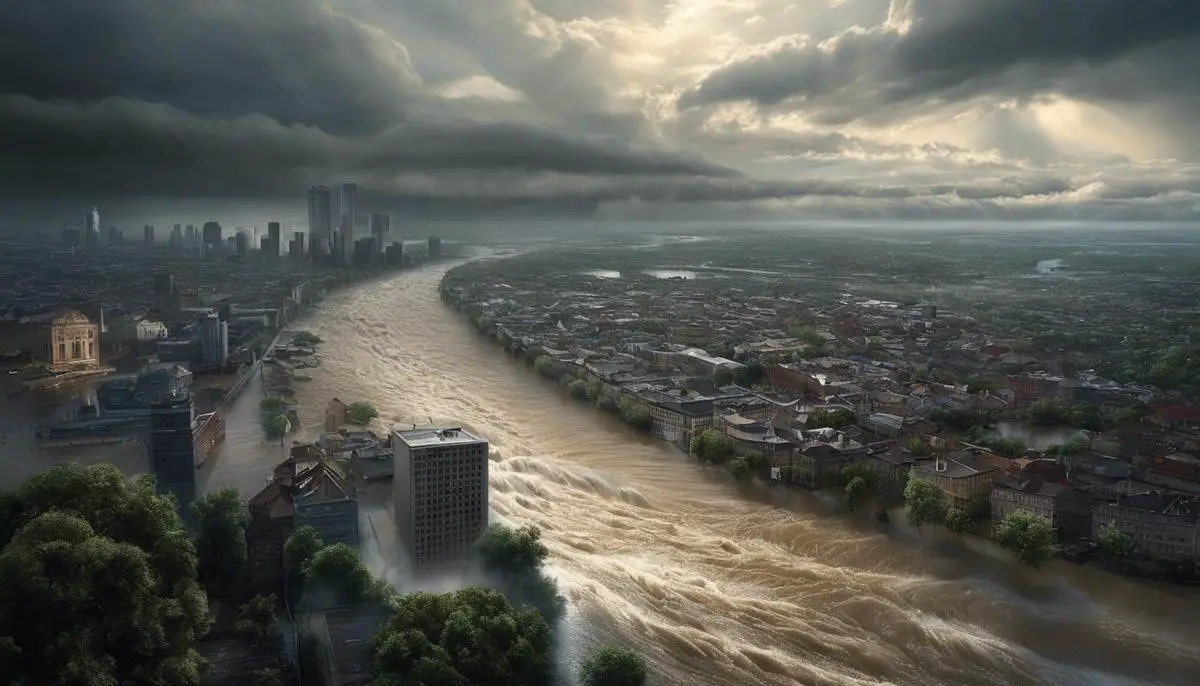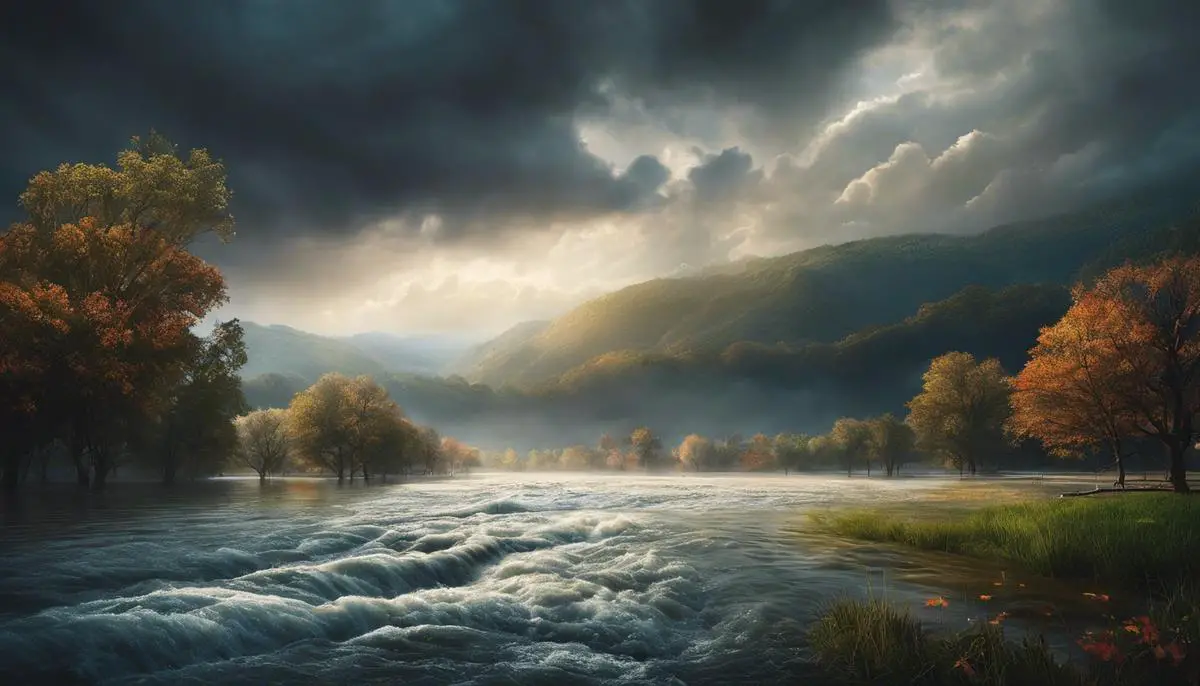When we retire to the world of dreams, our subconscious embarks on narratives that bewilder, inspire, or even startle us. Among the countless dream scenarios, one that frequently surfaces in the mind’s nocturnal theatre is that of flooding. This subject has piqued the curiosity of dream enthusiasts, psychologists, and neuroscientists alike, leading to a rich tapestry of interpretations and illustrations that span from the intimately personal to the universally cultural, and from the profoundly psychological to the cutting-edge neuroscientific. Both rich in significance and misunderstood, this essay shines a light on the multifaceted nature of flood dreams, seeking to provide a comprehensive look into the forces behind these dreams and the ways one can deal with their recurring appearance.
Psychological Dynamics of Flood Dreams
Unraveling the Unconscious: Psychoanalytic Interpretations of Flood Dreams
Floods represent one of the most ancient, powerful, and pervasive metaphors found nestled within the odyssey of human storytelling. They appear in religious mythologies, in literature, and indeed, in the unexplored realm of dreams. The exploration of flood dreams, with their distinctive dynamism and evocative symbolism, presents an intriguing portal into the human subconscious, and offers insights into an array of psychological processes and states.
Dream analysis has been a cornerstone of psychoanalytic theory since Sigmund Freud pioneered the field in the 20th century. According to Freudian interpretations, dreams can reveal latent thoughts, repressed emotions, and internal conflicts that the conscious mind may be attempting to suppress. From this perspective, dreams revolving around floods could symbolize an overflow of pent-up emotions or unexpressed feelings that are demanding release.
Moreover, water in dreams is often associated with the emotional dimension of the psyche. When observed as a tumultuous and uncontrolled element, as in floods, it may signify overwhelming feelings of anxiety, fear, or stress. It could also represent the feeling of being swept away or drowning in a real-life situation that the dreamer perceives to be beyond their control.
Floods also hold symbolic weight within the domain of Jungian psychology. The renowned Swiss psychiatrist Carl Jung advanced the idea of universal symbols, or archetypes, within the human subconscious. Here, floods can be viewed as an archetypal symbol of transformation and rebirth. In this sense, a flood dream might be an indication of a momentous shift in the dreamer’s life – a powerful tide of change washing away the old to give birth to the new.
On a slightly different note, flood dreams may also point towards issues related to destructive behaviors, or aspects of the self that are causing harm, leading to ‘flooding’ or overwhelming of the current state of being. This interpretation hints at the need to release or ‘drain away’ these detrimental behaviors, or else be engrossed by them.
Lastly, it is noteworthy to mention that although a plethora of symbolic interpretations exist, the significance of any dream is fundamentally subjective. The norms, culture, personal experiences, emotional state, and subconscious inclinations of the dreamer undeniably influence the individual meaning of flood dreams.
In understanding the depths of the human mind, dreams serve as a beacon, illuminating the path to self-realization and psychological wellbeing. By comprehending the complex language of our dreams, we can strive to master a more profound understanding of our inner landscape, the fears we conceal, the changes we desire, and the emotional waves that ebb and flow within us. And in doing so, we can harness the therapeutic potential of this mysterious, nocturnal narrative, and chart our course towards improved mental health and resilience.

Photo by pabloheimplatz on Unsplash
Cultural Perspectives on Flood Dreams
Beyond what has already been addressed in the discussion of flood dreams and their interpretations, it is important to delve further into cross-cultural views. Many cultures have their own take on water symbolism in general, and flood dreams specifically, rooted in centuries-old myths, legends, and spiritual beliefs.
In ancient Egypt, dreaming of floods would generally be seen positively due to the country’s reliance on the Nile’s inundation for agricultural fertility. Floods were signals that lent themselves to the pharaoh’s divine right, confirming that the gods were pleased. Thus, dreaming of a flood could be seen as a harbinger of prosperity and divine favor.
In contrast, in the Hebrew tradition, the flood narrative is one of divine wrath and subsequent renewal. This roots itself in the story of Noah’s ark in the Old Testament, where a great flood is sent as a divine punishment for humanity’s sins. Consequently, flood dreams might be interpreted as messages of forthcoming trials or the need for moral correction.
Native American cultures also postulate unique interpretations. Water is seen as a purifying and rejuvenating force, and dreaming of floods may symbolize spiritual cleansing or profound personal change. In some tribes, dreaming of a flood could also be seen as a powerful visionary message, warranting comprehensive interpretation by the community’s spiritual guide or shaman.
Across the Pacific, in many East Asian cultures like China and Japan, the emphasis is often on balance. Waterfalls, rivers, and floods are pervasive in folklore, symbolizing the flow of life’s energies. In this context, flood dreams might be interpreted as a possible life’s imbalance, calling for personal harmony and equilibrium.
In African cultures, water generally has a spiritual connotation including renewal, healing, and transformation. For instance, in Yoruba mythology, the goddess Oya is associated with winds, lightning, and violent storms, including floods. A Yoruba dreamer might interpret a flood dream as a contact with Oya, symbolizing transformation and change that could be tumultuous but ultimately beneficial.
A comprehensive look at these interpretations displays a remarkable interplay of cultural beliefs, spiritual elements, societal values, and individual perceptions. Each society offers unique magnifying lenses to view flood dreams, shading them with collective mythology, religious beliefs, and geographic realities.
In essence, flood dreams, like many aspects of human psychoanalytic endeavor, represent a dynamic human-nature and human-culture interface. Despite the inherent subjectivity, it engages broader discussions spanning human cognition, psychological spaces, social structures, cultural layers, and spiritual landscapes. These richly diverse perspectives enrich the global ‘dream tapestry,’ contributing to the nuanced, multi-dimensional realm of dream studies.

Neuroscience Behind Dreaming of Floods
Venturing beyond the thickened layers of human interpretation, culminating from centuries of tradition and belief, offers a chance to plunge into the verdant pool of neuroscience. The expanse of human brain shares a profound link with the fostering of dreams, involving not the subconscious compassion of Freudian or Jungian deliberations but a systematic approach to neural architecture.
Prominently, dreams, such as those depicting floods, occur during the Rapid Eye Movement (REM) sleep cycle, a period distinguished by increased brain activity. A neurological curiosity, vital areas of the brain involved in emotion and memory processing – namely the amygdala and hippocampus – exhibit increased activity during this period. The amygdala, master controller of our emotions, particularly fear and anxiety, may explain the heightened emotional realism contained within flood dreams. The hippocampus, custodian of our memories, assists in devising the coherent narrative of such dreams, uniting sporadic elements into a tangible storyline.
The prefrontal cortex, associated with logic and decision-making abilities, tells a different tale during REM sleep. Notably reduced in activity, this cerebral lobe grants free rein to the vocals of our emotions and memories, uncensored by the leash of rational judgement. Within such an interplay, flood dreams may harbor an anarchic quality, the inundation serving as a metaphor for unchecked emotionality or imposed transformations.
A scientific detour is also warranted to the arena of neurotransmitters. Neurons, the primary stakeholders in conveying messages across different parts of the brain, function via neurotransmitters – chemicals bridging the communique between these cells. Two dominant actors in the REM stage are acetylcholine and norepinephrine. Acetylcholine, found in abundance during this period, governs learning and memory, thus furnishing the canvas of our dreams with detailed intricacy. In contrast, norepinephrine, responsible for alertness and arousal during wakeful hours, features minimal presence during REM sleep. Consequently, even as the “floodwaters” rise in our dreams, the absence of norepinephrine paralyzes our capacity to “wake up and escape,” engendering an encapsulated sense of dread or helplessness.
Inescapably intertwined in this neuroscientific dance are the different stages of sleep. The alternating rhythm of REM and Non-REM sleep (NREM), each stage fostering unique neural characteristics, imprints its traits onto our dreams. Notably, dreams born in the arms of NREM are typically mundane or merely reflective of everyday occurrences. However, embarking on REM sleep, especially the latter stages, gives rise to vivid, emotional, and uncanny dream experiences including the flood dreams. In these dreams, cerebral architecture governs the narrative composition, emotional palette, and vivid realism.
From the neuroscientific perspective, flood dreams represent much more than mere night-time narratives. Instead, they form vital components of a complex cognitive machine, with concrete links to our emotional responses, encoded memories, neurotransmitter levels, and sleep stages. As the waters recede and daylight filters through, the remaining residue could provide invaluable insight into the unseen neurological landscapes and the fascinating phenomena we term as dreams.

Dealing with Recurrent Flood Dreams
Grasping flood dreams through the lens of Bio-Psycho-Social perspectives is an astonishing intellectual journey. To further enrich our understanding, a lot of intriguing findings have been unearthed from the multidisciplinary area that sits at the intersection of cognitive neuroscience, neurophysiology, and neuropsychology. These disciplines allow us to delve into a detailed investigation to comprehend how the brain generates, regulates and processes the experience of flood dreams during different stages of sleep.
Unarguably, the brain is the central hub where dreams, hallucinations, and imaginations are engendered. Cognitive neuroscientists and neurophysiologists are increasingly involved in examining the bio-psychological basis of dreams, especially the role and relevance of certain areas of the brain. In the case of flood dreams, it is worthwhile to examine the roles of the amygdala and hippocampus, two key elements in the limbic system, arguably the epicenter of emotions.
The amygdala, known as the brain’s emotional center, is largely responsible for processing fear-inducing stimuli. When linked with flood dreams, perhaps we see the amygdala ‘light up’ as it handles representations of overwhelming emotions, those encountered in dream sequences featuring floods. Neuroscience research on brain activity during REM sleep – the stage when most vivid dreaming takes place – supports the amygdala’s engagement, hinting at an intriguing correlation.
The hippocampus, vital for memory encoding and retrieval, also plays a pivotal role in associating emotions with specific memories. Therefore, recurring flood dreams might reflect the brain’s attempt to cope with past traumatic experiences that remain in our memory. Dreams hence can serve dual purposes – replaying disturbing memories (potentially linked with flooding), and attempting cognitive emotional regulation.
Another interesting facet of this discourse is the involvement of neurotransmitters in dream formation. Neurotransmitters are the brain’s chemical messengers, orchestrating a myriad of processes. Specifically, during the dreaming phase, the brain experiences a surge in acetylcholine levels, which plays a substantial role in regulating REM sleep, dream vividness, and emotional processing. On the other hand, norepinephrine, a neurotransmitter associated with ‘fight or flight’ responses, is fundamentally absent.
The interplay of these neurotransmitters may fuel flood dreams. The overdrive of acetylcholine could heighten emotional processing, making the flood dreams more intense. Simultaneously, the absence of norepinephrine, our ‘panic suppressor’, may help to keep the dreamer passive in the face of fear-laden flood dreams.
Furthermore, studies have associated fluctuations in neurotransmitter levels with variations in dream content. Hence, flood dreams could potentially be pointers towards underlying shifts in these key bio-chemicals.
Therefore, understanding the brain’s neurophysiology is not only an exploration of human biology but also a unique foray into the complex realm of human emotion, cognition, and consciousness. The neural map drawn by flood dreams challenges and reshapes our understanding of the intricate and enigmatic human brain, sleep, and dreams.
To conclude, the analysis of recurring flood dreams transcends beyond static concepts; it becomes a dynamic intersection of psychoanalytic thought, cultural anthropology, and neuroscience. This feted gathering of mammoth intellections from three diverse fields forms an absorbing commentary on human thought, behavior, and brain. The fascinating world of flood dreams thus remains a profound testament to the enduring enigma of the human mind.

Flood dreams weave a complex tapestry of human emotion and psychology, colored by cultural perspectives, and braced up by the structures of our sleep-driven brain activity. The wealth and variety of interpretation available illuminate, not only the diversity of human experience but also the profound interconnectedness of our inner and outer worlds. By understanding this, we gain a powerful tool in navigating significant life transitions, dealing with unresolved emotions, or simply achieving a richer understanding of our inner selves. While dreams of floods can be alarming, they offer us an opportunity for introspection and personal growth. Approaching them with the knowledge and strategies discussed ensures that we can turn these enigmatic nocturnal narratives into sources of insight and empowerment.
